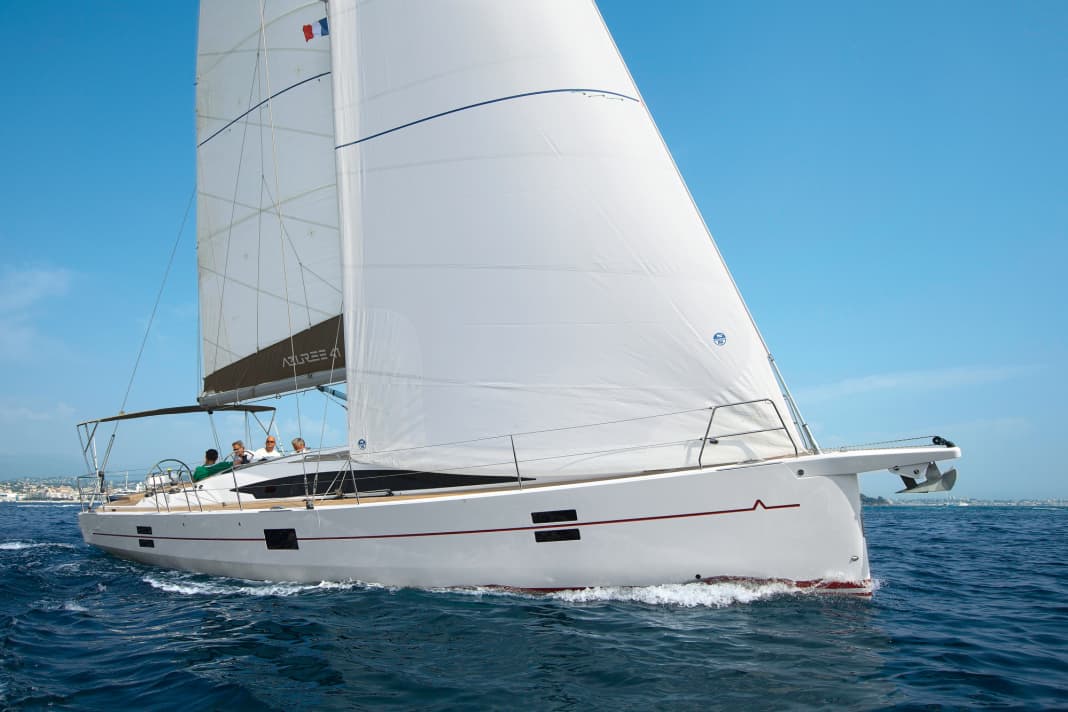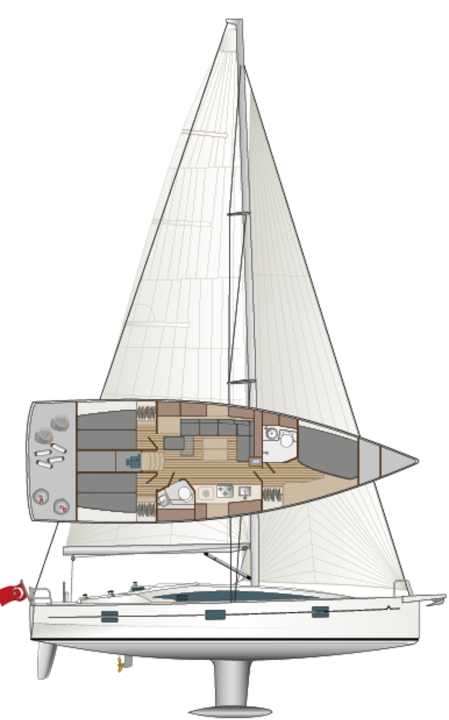





It doesn't really fit together. On the one hand, there is a boat with an apparently extremely sporty, performance-orientated basic design. On the other hand, a completely unsportsmanlike bimini sunroof spans the steering positions aft, as is often the case with cruising boats on Caribbean charters, for example. The best of both worlds, of course, but in a somewhat strange combination.
Even if in this specific case it is only the customer who wants it that way: the synthesis of requirements for unrestricted and uncompromising cruising with a good dose of sportiness and performance is becoming more trendy again. Some shipyards are now using the term "fast cruiser" instead of "performance cruiser".
The Azuree 41 is the successor to the Azuree 40, with which the Sirena Marine shipyard debuted on the market in 2011, together with the smaller Azuree 33. In the meantime, the shipyard has extended the line further upwards with the Azuree 46 and secured the services of designer Rob Humphreys. The Briton has now also designed the 41 in a visually very similar style. The differences can be seen almost exclusively below deck.
Competition from the Azuree 41
- Solaris 40: Performance cruiser with breathtaking looks and powerful performance
- Luffe 40.20: Facelift of an exceptional cruising yacht
- X 4.3: Travelling in comfort and sailing fast - both are possible
Makes you want more
Unfortunately, the test under sail is not under a good star. The weather in Cannes on the Côte d'Azur promised plenty of sunshine for the test day, but hardly any wind. In the afternoon there is a light thermal, but no more than 5 knots of wind. Nevertheless, even in these conditions, the Azuree is able to give a remarkable demonstration of its performance capabilities.
With a total weight of 8.6 tonnes, the boat, which is not particularly light, immediately converts the little pressure into good speed and also gets going again quickly after the tacks. Hard on the wind, 4.7 knots of speed are measured at an angle of 45 degrees to the wind direction. Of course, these values from the light wind test are not very meaningful. The larger Azuree 46 with its almost identical hull shape and similar rig concept was convincing in the strong wind test in high swell. The smaller 41 will presumably be able to do the same in stronger winds.
Steering downwind is certainly a pleasure. The finely tuned Jefa system works with separate cables from the wheels directly to the respective quadrants, which in turn are connected below deck with a push rod. Although this installation is complex and cost-intensive, it provides a great deal of feeling on the wheel thanks to the very short controls.
The system is also doubly safe because the cables are separate. If one of the steering units should fail, the boat can still be steered from the second wheel without any restrictions. What's more, the entire steering system is easily accessible through the aft cabins. For boats with double rudders in particular, the position of the steering fins must be checked repeatedly to ensure optimum performance and readjusted if necessary.
Lots of deflection, lots of friction
The layout in the cockpit corresponds to the tried and tested arrangement for sporty yachts of this type. The halyards and trim lines are led to the side of the companionway, where they are clipped via batteries of halyard stoppers. Primary and secondary sheet winches are available on the cockpit coaming for the mainsheet and genoa sheet. However, the lines, which are usually led below deck, are often stiff due to the many deflections and the additional friction in the channels. The mainsheet in particular gets jammed and has to be tightened by hand when furling.
Of course, you don't have to have the bimini roof over the helm cockpit, but it still protects the helmsman well from the sun or rain. The flexible helmsman's seats in the stern are also an extra. These can be removed and can remain on the jetty. The large sail load in the foredeck measures 1500 litres in total. Space windsails such as gennakers or code zero can be stored here, as well as fenders and mooring lines. The sail storage space in the bow, which is separate from the anchor locker, is unusual for a boat of this size, but also extremely welcome. This is because the forecastle boxes in the cockpit are quite shallow due to the aft cabins below.
Seldén's twin-reef rig is through-hull and stands on the very solidly constructed floor assembly. Like the deck and the hull, it is also built using the vacuum infusion process with vinyl ester resin. The shipyard laminates additional carbon fibre reinforcements in the extended area of the keel flange and shroud mounts. The putter plates are bolted to the outside of the hull.
Second bathroom only as an option
For the interior fittings, the customer can choose between light-coloured oak (standard), the evenly grained mahogany or the rather dark and unevenly textured walnut wood. The quality of workmanship and craftsmanship is remarkable, right down to the smallest detail. At Sirena Marine, not only are all GRP parts including the hull and deck built in-house, but also the entire interior from A to Z.
The layout below deck consists of two identically sized aft cabins and one forward cabin. The standard layout only provides for one bathroom in the forward cabin. A second bathroom, as is usual in the length class, is only available for an extra charge. The toilet rooms are also quite small.
The bunk in the foredeck is built in lengthways at the side, which is great if you are sleeping there alone - but it is a bit cramped for two people: the berth is just 1.25 metres wide at shoulder height. As an alternative, the shipyard offers a wider triangular-shaped berth.
With a width of 1.28 metres, the berths in the aft cabins are also too narrow for two adults. The reason for this is the 70 centimetre wide service channel between the two compartments. In addition to the Yanmar built-in engine, the boiler, the heating and the electrical installations, there would also be space for a generator. The technical installations are also easily accessible through the aft cabins.
Deliberate demarcation
Another special feature of the Azuree 41 is the long, side-mounted galley in the saloon. Although this arrangement has generally gone somewhat out of fashion, it still has its friends and supporters, especially on owner's boats and in the cruising sector. On performance boats, however, the long galley is rare. In this respect, the Azuree 41 can score points in the competitive environment with another unique selling point. The advantage of the galley is its large work surface and the many easily accessible storage compartments. The usual second saloon sofa has to be sacrificed for this. If all cabins were fully occupied with a total of six people, eating at the saloon table would be quite cramped.
The price of the Azuree 41 is attractive compared to the competition, especially if you look at the basic prices: The boat costs a good 220000 euros ex shipyard. As is usual in the performance boat class, the sails are not included. The German sales department of Nordic Yachting in Neustadt calculates additional costs of at least 11,000 euros for the simple wardrobe (main and genoa), depending on quality and design.
Buyers with high cruising demands also have to purchase additional amenities such as the folding bathing platform or the cockpit table.
Thanks to its many special features and exclusivity, the Azuree 41 offers a pleasant distinction from the rest of the market for sporty touring boats. The compromise is very exciting because it is rare.
The measured values for testing the Azuree 41




The Azuree 41 in detail

Technical data of the Azuree 41
- Design engineer:Rob Humphreys
- CE design category:A
- Torso length:12,50 m
- Width:3,93 m
- Draught/alternative:2,40/2,00 m
- Weight:8,6 t
- Ballast/proportion:3,14 t/37 %
- Mainsail:55,8 m2
- Furling genoa (106 %):44,2 m2
- machine (Yanmar):29 kW/39 hp
Hull and deck construction
GRP sandwich with PVC foam core and vinyl ester resin. Built using the vacuum infusion process
Price and equipment
- Base price ex shipyard: 235,620 euros without sails
- Warranty/against osmosis: 2/2 years
Prices as of 09/2023, as the prices shown are defined, you will find here !
Shipyard
Sirena Marine, Orhangazi-Bursa (Turkey); https://sirenamarine.com.tr/azuree/
Distribution
YACHT review of the Azuree 41
Chic and powerful performance cruiser from Turkey with a very broad orientation. Beautifully built to a high standard, especially below deck. Interior layout with long kitchenette at the side. Attractive base price
Design and concept
- + Successful compromise
- + Solid, high-quality construction
- + Sail load in the forecastle
Sailing performance and trim
- + Agile sailing characteristics
- + Well-tuned steering gear
Living and finishing quality
- + Beautifully crafted finishing work
- - Second wet room only as an option
- - Narrow berths fore and aft
Equipment and technology
- + Good basic equipment
- + Steering mechanism very easy to reach
- - Bathing platform only as an extra
This article first appeared in YACHT 02/2017 and has been revised for this online version.

